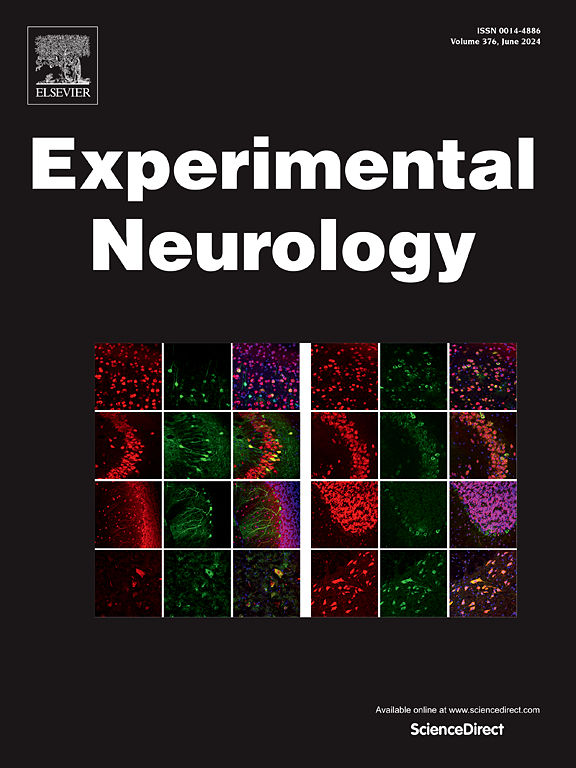Tg-SwDI转基因小鼠:用于阿尔茨海默病和脑淀粉样血管病基础研究和临床前研究的合适模型
IF 4.2
2区 医学
Q1 NEUROSCIENCES
引用次数: 0
摘要
阿尔茨海默病(AD)是最常见的神经退行性疾病,也是痴呆症的最常见原因。在AD患者的大脑中观察到的特征是淀粉样β肽(Aβ)聚集体的积累,由过度磷酸化的Tau蛋白组成的神经原纤维缠结(NFT),神经元和突触丢失,氧化应激和炎症标志物水平升高。脑淀粉样血管病(CAA)是认知能力下降的另一个常见原因,其特征是脑血管中Aβ的积累。AD和CAA同时发生的确切重叠致病机制尚不清楚。然而,早期观察到的血管功能障碍被认为是一个关键现象。Tg-SwDI转基因小鼠表达人Aβ前体蛋白(a - β pp),在大脑中携带瑞典K670N/M671L和荷兰/爱荷华E693Q/D694N突变,已被广泛用于研究AD/CAA患者的许多病理特征,并设计生物标志物和治疗策略。本文综述了在Tg-SwDI小鼠中模拟人类疾病的不同特征的研究:实质和脑血管淀粉样蛋白积累、神经炎症、补体过度激活、脑血管、线粒体和gaba能系统功能障碍、NO合成改变、昼夜节律中断、铅暴露效应等。此外,还分析了评估抗a β和抗炎策略以及能够延缓或逆转Tg-SwDI小鼠血管功能障碍和gaba能传递损伤的化合物的报告。这篇综述可能有助于研究人员确定该模型是否适合未来特定机制或新治疗方案的研究。本文章由计算机程序翻译,如有差异,请以英文原文为准。
Tg-SwDI transgenic mice: A suitable model for Alzheimer's disease and cerebral amyloid angiopathy basic research and preclinical studies
Alzheimer's disease (AD) is the most common neurodegenerative disease and the most frequent cause of dementia. Characteristic features observed in the brain of AD patients are the accumulation of amyloid beta peptide (Aβ) aggregates, neurofibrillary tangles (NFT) composed of hyperphosphorylated Tau protein, neuronal and synaptic loss, and elevated levels of oxidative stress and inflammatory markers. Cerebral amyloid angiopathy (CAA) is another common cause of cognitive decline characterized by the accumulation of Aβ in the cerebral vasculature. The precise overlapping pathogenic mechanisms underlying the co-occurrence of AD and CAA are not very well understood. However, vascular dysfunction observed at early stages is considered a key phenomenon. Tg-SwDI transgenic mice expressing human Aβ precursor protein (AβPP) harboring the Swedish K670N/M671L and vasculotropic Dutch/Iowa E693Q/D694N mutations in the brain have been extensively used to study many pathological features observed in AD/CAA patients and to design biomarkers and therapeutic strategies. The present review summarizes studies addressing different features mimicking human disease in Tg-SwDI mice: parenchymal and cerebral vascular amyloid accumulation, neuroinflammation, complement overactivation, cerebrovascular, mitochondrial and GABAergic system dysfunction, altered NO synthesis, circadian rhythm disruptions, lead exposure effect, among others. Also, reports that evaluated anti-Aβ and anti-inflammatory strategies and compounds capable of delaying or reversing vascular dysfunction and the impairment of GABAergic transmission in Tg-SwDI mice are analyzed. This review may help researchers determine this model's appropriateness for future studies of a particular mechanism or a novel treatment protocol.
求助全文
通过发布文献求助,成功后即可免费获取论文全文。
去求助
来源期刊

Experimental Neurology
医学-神经科学
CiteScore
10.10
自引率
3.80%
发文量
258
审稿时长
42 days
期刊介绍:
Experimental Neurology, a Journal of Neuroscience Research, publishes original research in neuroscience with a particular emphasis on novel findings in neural development, regeneration, plasticity and transplantation. The journal has focused on research concerning basic mechanisms underlying neurological disorders.
 求助内容:
求助内容: 应助结果提醒方式:
应助结果提醒方式:


